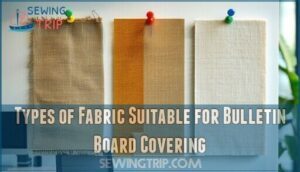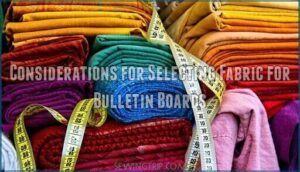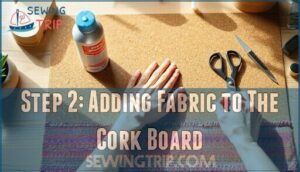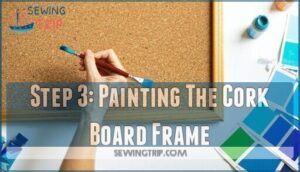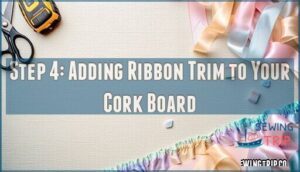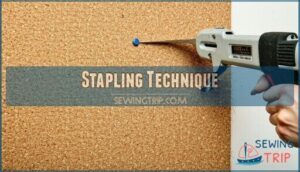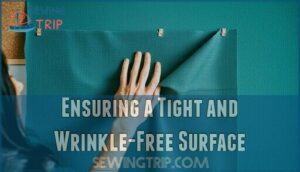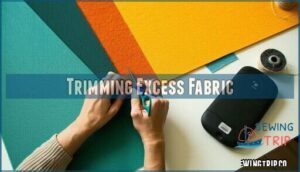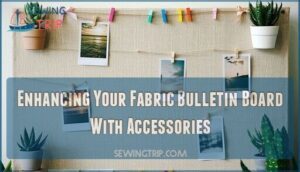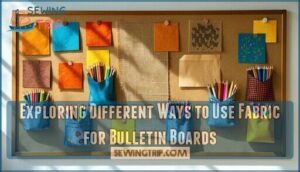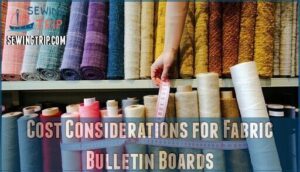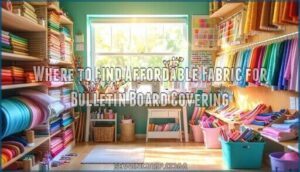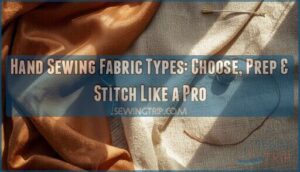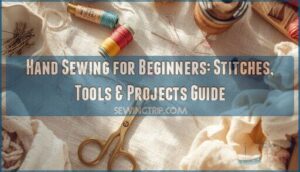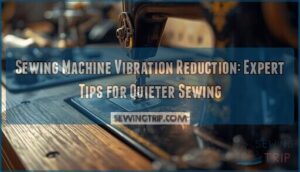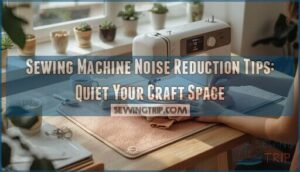This site is supported by our readers. We may earn a commission, at no cost to you, if you purchase through links.
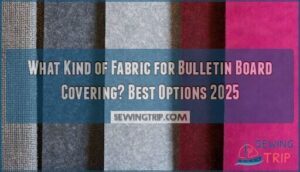
It’s tough enough to handle countless pins without looking like Swiss cheese, yet soft enough that pushpins slide in easily. Cotton grips pins securely, keeping your notes right where you put them.
Felt works great too, especially for heavy-duty boards since it distributes pin pressure better.
Skip synthetic fabrics – they show every pin hole and can look cheap over time.
Choose solid colors or subtle patterns that won’t compete with your displayed items. The right fabric choice makes all the difference between a board that looks professional and one that screams "crafty disaster.
Table Of Contents
- Key Takeaways
- Choosing The Right Fabric for Your Bulletin Board
- Types of Fabric Suitable for Bulletin Board Covering
- Considerations for Selecting Fabric for Bulletin Boards
- Step-by-Step Guide: How to Cover a Cork Board With Fabric and Ribbon
- Tips for Attaching Fabric to a Bulletin Board
- Enhancing Your Fabric Bulletin Board With Accessories
- Factors to Consider When Estimating The Amount of Fabric Needed
- Exploring Different Ways to Use Fabric for Bulletin Boards
- Cost Considerations for Fabric Bulletin Boards
- Where to Find Affordable Fabric for Bulletin Board Covering
- Frequently Asked Questions (FAQs)
- Conclusion
Key Takeaways
- Choose medium-weight cotton for the best balance – You’ll get fabric that’s tough enough to handle countless pins without looking worn, yet soft enough for easy pushpin insertion and a secure grip.
- Skip synthetic fabrics to avoid a cheap appearance – You’ll prevent pin holes from showing prominently and maintain a professional look over time, as synthetics do not age as gracefully as natural fibers.
- Consider felt for heavy-duty applications – You’ll benefit from superior durability and better pin pressure distribution, making it ideal for boards that get frequent use in busy environments.
- Stick with solid colors or subtle patterns – You’ll ensure your displayed materials remain the focus rather than competing with busy fabric designs that can make your board look unprofessional.
Choosing The Right Fabric for Your Bulletin Board
Choosing the right fabric transforms an ordinary cork board into a functional and attractive display piece.
You’ll want to keep in mind factors like durability, maintenance requirements, and how well different materials hold up to frequent pinning when making your selection.
Cotton Vs. Synthetic Fabrics
When choosing between cotton and synthetic fabrics for bulletin boards, you’ll find distinct differences in fabric durability and cost comparison.
Cotton fabric offers natural texture and breathability, while synthetic fabrics provide superior fabric lifespan and lower environmental impact through recycling options.
Consider these fabric selection factors:
- Durability and longevity: Synthetic fabrics resist fading and wear better than cotton
- Texture differences: Cotton feels softer, synthetics offer smoother surfaces
- Best uses: Cotton suits temporary displays, synthetics work for high-traffic areas
Choosing Fabric Patterns
Pattern selection depends on your bulletin board’s purpose and environment.
Solid colors work best for professional settings, while geometric patterns add visual interest without overwhelming content.
Floral patterns suit classrooms or home offices.
Consider pattern scale – small prints work better than large motifs that compete with posted materials.
Match your color palette to existing decor for a cohesive look.
Pre-coordinated collections offer a simple way to guarantee a harmonious color palette.
Durability and Maintenance
After picking your favorite print, think about durability and maintenance. You’ll want a durable fabric board that stands up to daily use.
Fabrics with stain resistance and easy clean fabric care make life simpler. Avoid sunlight fading by keeping boards away from windows.
Regular cleaning methods, like gentle spot cleaning, help with fabric longevity. Quick repair techniques keep your board looking fresh.
Types of Fabric Suitable for Bulletin Board Covering
You’ll want to choose a fabric that balances durability with visual appeal for your bulletin board project.
The three main fabric categories each offer distinct advantages depending on your specific needs and environment.
Cotton Fabric
Cotton stands out as the most popular bulletin board fabric choice for good reason.
Natural fibers bring durability and endless design possibilities to your bulletin board project.
This natural fiber offers excellent cotton durability that withstands frequent pinning without tearing.
You’ll find cotton weaves in countless varieties, from tight twills to loose canvas constructions.
Organic cotton provides an eco-friendly option that’s chemical-free and safe for classrooms.
Cotton prints give you endless design possibilities – florals, geometrics, solids, and themed patterns work beautifully as bulletin board material.
Cotton blends combine natural fibers with synthetics for added strength and wrinkle resistance.
The fabric accepts staples easily and holds pins securely without fraying.
Your fabric choices expand dramatically with cotton’s versatility.
It’s affordable, machine washable, and maintains color vibrancy over time.
Cotton bulletin board fabric creates smooth surfaces perfect for displaying student work or office announcements.
Felt Fabric
Felt fabric offers superior durability compared to cotton, resisting fraying and maintaining its shape through repeated pin use.
This bulletin board material comes in vibrant felt colors and various felt thickness options.
Felt textures provide acoustic benefits, absorbing sound in busy classrooms.
Dense fibers guarantee pins hold securely without sagging, and felt applications extend beyond basic covering—its uniform surface creates professional displays.
Choose felt fabric for bulletin board projects requiring frequent updates and long-term use.
Stretchy Fabric
Jersey and knit fabrics bring unique advantages to your stretch fabric board projects.
These fabric types offer excellent stretch durability and knit thickness that creates a tight and wrinklefree surface.
You’ll find application ease when working with stretchy fabric since the material conforms smoothly to your board’s contours.
The wrinkle resistance helps maintain a professional appearance over time.
While pin holding capability may be slightly reduced compared to felt, fabric stretching properties make installation straightforward.
These synthetic fabric types provide cost-effective solutions for bulletin boards requiring frequent updates, with excellent properties for the task.
Considerations for Selecting Fabric for Bulletin Boards
When you’re selecting fabric for your bulletin board, you need to think about how it’ll hold up over time and whether it fits your space and budget.
The right choice depends on factors like durability, size requirements, and cost considerations that’ll make your project both functional and affordable.
Durability and Longevity
Smart fabric selection means thinking beyond just looks.
**Durability beats beauty when pins meet fabric daily.
Your fabric lifespan depends on choosing materials that handle daily wear resistance.
Heavy-duty cotton and thick polyester blends offer excellent fabric durability for longterm use.
These fabrics resist punctures from pins and maintain their appearance after countless uses.
Fade resistance matters too.
Darker colors and synthetic blends keep their vibrancy longer than light fabrics.
Quality materials like marine-grade vinyl or felt withstand years of classroom abuse without showing wear.
Fabric maintenance stays simple with durable choices.
Regular dusting and spot cleaning preserve fabric quality.
While initial fabric costs might seem higher, long-term costs decrease when you’re not replacing worn boards every year, which is a result of long-term use and choosing the right materials for daily wear resistance, considering fade resistance and the overall fabric durability.
Size and Dimensions
When planning your fabric selection, measuring dimensions accurately guarantees proper coverage and prevents costly mistakes.
Board size directly affects how much material you’ll need and influences your dimensional planning approach.
Consider these key measurement factors:
- Fabric width – Choose fabric wider than your board to avoid piecing sections together
- Coverage area – Measure the front surface plus wrap-around space for edges
- Seam allowance – Add 4-6 inches beyond board edges for secure attachment
- Board shape – Irregular shapes require extra fabric for proper folding and tucking
- Custom sizes – Non-standard boards need precise measurements to avoid waste
Calculate total fabric needs by measuring length and width, then adding seam allowances to each dimension for proper coverage.
Budget-Friendly Options
During seasonal sales, you can slash fabric costs by up to 60% at major craft stores.
Remnant hunting at discount stores yields quality materials for pennies on the dollar.
| Source | Average Cost | Best For |
|---|---|---|
| Thrift stores | $1-3 per yard | Unique patterns, cotton blends |
| Online retailers | $2-5 per yard | Bulk purchases, polyester |
| Fabric remnants | $0.50-2 per yard | Small boards, felt sheets |
These budget-friendly options include clearance cotton, polyester blends, and felt sheets. Upcycled linens from thrift stores can also be a great option. Check dollar stores for affordable fabric options that work perfectly for bulletin boards.
Step-by-Step Guide: How to Cover a Cork Board With Fabric and Ribbon
Creating a fabric-covered cork board transforms a simple bulletin board into a stylish organizational tool that matches your decor.
You’ll need basic supplies and about an hour to complete this straightforward project that gives professional-looking results.
Step 1: Preparing The Cork Board
Begin by masking the cork board frame with painter’s tape to protect it during fabric application. Cut your fabric approximately two inches larger than the board’s size and dimensions on all sides.
This extra material guarantees proper coverage during the stapling technique. Before starting your step-by-step guide, consider that pre-washing prevents shrinkage.
Remove any dust or debris from the cork surface before starting your step-by-step guide. Proper frame masking and fabric cutting create clean edges for adhesive preparation and bubble removal later.
Step 2: Adding Fabric to The Cork Board
Now you’ll cut the fabric to size and attach it to your prepared cork board using proper adhesive application techniques. Position the fabric carefully to guarantee perfect fabric alignment before securing it in place.
- Apply spray adhesive outdoors in thin, even coats to prevent excessive buildup
- Smooth fabric from center outward using firm pressure for effective bubble removal
- Work systematically across the surface to eliminate air pockets and wrinkles
- Complete fabric trimming with sharp tools for a clean, neat finish around edges
Consider adhesive options for fabrics for superior results. This step is crucial for achieving a clean, neat finish and ensuring the fabric is securely attached with effective bubble removal techniques.
Step 3: Painting The Cork Board Frame
Now paint your frame to match your fabric choice.
Start with frame preparation by cleaning any dust or debris from the surface.
Choose paint types that work well on your bulletin board material – acrylic craft paint offers the best coverage and durability.
Consider various paint products for your project.
Use color matching techniques by holding fabric samples against different paint colors under natural light.
Apply thin, even coats using smooth painting techniques for a professional finish on your decorative bulletin board.
Step 4: Adding Ribbon Trim to Your Cork Board
After you’ve painted your cork board frame, it’s time to elevate your bulletin board with decorative ribbons and fabric borders.
These finishing touches transform a plain board into an eye-catching focal point.
- Choose complementary ribbon colors that match your fabric and room decor for seamless integration
- Apply fabric glue along edges for secure ribbon attachment, ensuring clean corner detailing
- Layer patterned ribbons with overlapping ribbons technique for visual depth and texture
- Consider ribbon alternatives like fabric strips or decorative border materials for unique styling
Adding ribbon trim creates polished fabric embellishments that elevate your finished project.
You can find a wide array of options online.
Tips for Attaching Fabric to a Bulletin Board
You’ll need to secure the fabric properly and create a smooth surface for an attractive finish.
The right technique guarantees your fabric stays tight and looks professional for years of use.
Stapling Technique
Your staple gun choice matters more than you’d think.
Heavy-duty models work best for thick cork board covering, while manual versions suit lighter fabric pin board projects.
Use quarter-inch staples spaced every two inches along edges.
Start at the top center, then alternate sides to maintain tension control.
Pull fabric tight as you work, preventing wrinkles and avoiding rips.
Secure corners first with extra staples for stability.
Angle your staples slightly for better grip through the bulletin board covering material.
Ensuring a Tight and Wrinkle-Free Surface
Achieving a smooth finish requires careful attention to fabric tension and proper attachment methods.
A professional-looking bulletin board starts with consistent stretching techniques that eliminate wrinkles before they form.
Here’s how to guarantee perfect fabric tension:
- Begin with center points – Start stapling at the top center, then bottom center, creating initial fabric tension across the board’s length.
- Work systematically outward – Move from center points toward corners, maintaining consistent pull pressure on the fabric as you go.
- Check fabric texture alignment – Keep patterns or weaves straight by monitoring fabric orientation throughout the adhesive application process.
- Focus on wrinkle resistance – Pull fabric taut at each staple point, smoothing out any creases with your free hand before securing.
- Perfect frame attachment – Ensure fabric lies flat against the frame edges, preventing slippage that causes bubbles or loose spots later.
These smoothing techniques create a professional appearance that’ll last through countless pin changes and daily use.
Trimming Excess Fabric
After securing the fabric with staples, use sharp cutting tools like scissors or a rotary cutter for measurement accuracy.
Trim excess fabric leaving about one inch around edges. Focus on neat corners by cutting diagonal slits to prevent bunching.
Clean edge finishing guarantees your polished finish looks professional. Remove fabric waste as you work.
Apply fabric glue to secure loose edges if needed during trimming excess fabric process, ensuring a neat and clean finish.
Enhancing Your Fabric Bulletin Board With Accessories
Once you’ve securely attached your fabric to the bulletin board covering, accessories transform your basic board into a functional workspace. Decorative elements like ribbon borders create visual appeal while organizing content.
Photo displays become more polished when you add custom pins that match your fabric patterns. Themed accessories help create cohesive displays.
For classroom boards, seasonal cutouts complement educational themes. Office spaces benefit from sleek magnetic clips and label holders. Colorful pins serve dual purposes—they categorize information and add visual interest.
Theme embellishments shouldn’t overwhelm your fabric choice. Select accessories that enhance rather than compete with your bulletin board covering. Ribbon grids organize photos without puncturing papers. LED string lights provide both illumination and decoration.
Practical accessories improve functionality. Dry-erase overlays convert sections into memo spaces. Small pouches attached to board edges store markers and pins. Calendar inserts blend scheduling with decorative appeal. These enhancing with accessories strategies create boards that work harder while looking better.
Factors to Consider When Estimating The Amount of Fabric Needed
Getting the fabric amount right prevents costly mistakes and guarantees complete coverage for your bulletin board project.
You’ll need to account for your board’s dimensions, fabric width, and a bit extra for wrapping and potential errors.
Fabric Width Considerations
When buying fabric, you’ll encounter different fabric width considerations that directly impact estimating fabric needed.
Standard fabric materials come in various widths, affecting your fabric options and overall project success.
Here are key fabric width considerations:
- Usable Fabric Width – Most fabrics range from 44-60 inches wide, with quilting cotton typically 44 inches
- Pattern Repeat Impact – Large patterns may require extra fabric to match designs across seam placement options
- Multiple Width Layouts – Wider fabrics reduce seams but cost more per yard than standard widths
Understanding fabric variety helps with minimizing fabric waste and guarantees you buy the right amount for your bulletin board project.
Measuring Bulletin Board Dimensions
You’ll need accurate measurements to determine fabric yardage needed.
Measure your bulletin board’s height and width, then add extra inches for seam allowance.
Board size impact directly affects fabric requirements – larger dimensions need more material.
When calculating seam allowance, account for mistakes and wrapping around edges.
Standard boards typically need one yard, but large board dimensions require proportional increases in fabric materials, which directly relates to board size and seam allowance, and ultimately affects the fabric requirements.
Budget-friendly Fabric Options
When searching for budget-friendly options, clearance sections offer discounted remnants at up to 75% off regular prices.
Teacher discounts and seasonal fabrics provide additional savings at fabric stores. Thrift shops stock affordable curtains and tablecloths perfect for large boards.
Online retailers feature cost-effective synthetic blends and cotton remnants. A key consideration is to select appropriate fabric types for ease of use.
These budget-friendly options keep projects under $20, making them a great choice for those looking for affordable solutions.
Exploring Different Ways to Use Fabric for Bulletin Boards
Beyond traditional mounting, fabric versatility opens doors to creative classroom decor possibilities.
Themed boards using seasonal patterns or custom printing transform bulletin boards into engaging visual displays. Fabric textures like felt or burlap add acoustic benefits, reducing noise while enhancing visual appeal.
Upcycling fabrics from old clothing creates unique bulletin board upholstery. Consider fabric creativity through layering different textures or creating removable fabric panels for easy updates.
These approaches maximize fabric’s potential beyond basic covering techniques, using fabric creativity to enhance the classroom environment.
Cost Considerations for Fabric Bulletin Boards
When planning your fabric bulletin board project, smart shopping strategies can stretch your dollar further.
Check clearance sections for discounted remnants that work perfectly for smaller boards. Many stores offer teacher discounts year-round, while thrift shops hide unexpected fabric treasures.
Online retailers frequently run sales on budget-friendly options. Consider seasonal fabrics during off-peak times for cost-effective materials that deliver lasting value.
Where to Find Affordable Fabric for Bulletin Board Covering
Finding budget-friendly fabric doesn’t have to break the bank. Smart shoppers know where to look for quality materials at discounted prices.
Discount Stores and Clearance Sections: Big-box craft stores like Joann and Michaels offer 40-60% off coupons, bringing cotton fabric under $3 per yard. Check clearance sections for remnants at up to 70% off regular prices.
Online Retailers: Browse fabric retailers like Fabric.com and Fashion Fabrics Club for deals starting at $1.99 per yard. Amazon and eBay feature bulk bundles covering multiple boards for $9.99-$19.99.
Thrift Shops and Repurposed Materials: Visit Goodwill or Salvation Army for donated fabric remnants as low as $0.99. Old bed sheets and curtains make excellent upcycled bulletin board covers.
- Check teacher discounts at fabric stores for additional savings on classroom projects
- Shop seasonal fabrics during off-peak times for themed bulletin boards
- Join local Buy Nothing groups where community members share surplus craft supplies
Frequently Asked Questions (FAQs)
Which fabric is best for a bulletin board?
While paper tears and plastic cracks, fabric offers lasting durability for your bulletin board.
Cotton and felt work best—they’re thick enough to hide pin holes, stretch smoothly over surfaces, and withstand daily use without showing wear.
What should I consider when covering a bulletin board?
You’ll need to take into account fabric thickness, durability, color coordination with your space, pin-holding capability, maintenance requirements, and your budget when selecting material for covering your bulletin board.
Can You cover a bulletin board with fabric?
You can cover a bulletin board with fabric easily.
Choose cotton, felt, or polyester for durability.
Cut fabric larger than the board, secure with staples or spray adhesive, then trim excess edges for a professional finish.
Is canvas fabric suitable for bulletin boards?
Good things come to those who wait" applies perfectly here.
Canvas fabric works excellently for bulletin boards since it’s strong, durable, and handles heavy-duty staples well, though you’ll need extra effort securing it properly.
What is a fabric bulletin board?
A fabric bulletin board features cloth material stretched over a corkboard base, creating a soft surface for pinning documents, photos, and decorations while adding visual appeal to your space.
Can Velcro be used on a bulletin board?
Yes, you can use Velcro on bulletin boards.
Linen fabric works particularly well with Velcro adhesives, providing a secure attachment surface.
The soft hook-and-loop system lets you easily reposition items without damaging the fabric or leaving permanent holes like traditional pins would, making it a convenient option with minimal disruption.
What material is used for bulletin boards?
Like building blocks for creativity, bulletin boards typically use cork as their foundation material.
You’ll find dense cork backing that holds pins securely, covered with fabric like cotton, felt, or polyester for durability and visual appeal.
What can I use to cover a cork board?
You can cover cork boards with cotton, felt, burlap, canvas, or polyester fabrics.
These materials provide durability, hold pins well, and resist fading while offering various colors and textures for customization.
How to attach fabric to poster board?
Attaching fabric to poster board is like wrapping a present with precision.
Use spray adhesive for smooth coverage, stretching fabric taut while smoothing out bubbles.
Trim excess edges carefully for a clean finish.
What is bulletin board material called?
Bulletin board material includes cork, foam board, fabric-covered cork, felt boards, and magnetic surfaces. You’ll commonly find cork boards, fabric-wrapped boards, and foam core backing.
Conclusion
Your bulletin board’s success hinges on choosing what kind of fabric for bulletin board covering that balances durability with functionality.
Medium-weight cotton emerges as the clear winner, offering the perfect combination of pin-holding strength and easy installation.
Felt provides excellent durability for high-use boards.
Remember to select solid colors or subtle patterns that won’t compete with your displayed materials, to create a professional-looking board that serves you well for years.
- https://performingineducation.com/simple-fabric-bulletin-board-tutorial/
- https://www.mixmeasuremake.com/make-a-fabric-covered-cork-board/
- https://almostpractical.com/fabric-covered-bulletin-board-diy/
- https://www.reddit.com/r/Teachers/comments/vao9tn/best_material_to_decorate_bulletin_boards/
- https://www.tiktok.com/@theeppichclassroom/video/7525238860226252063

